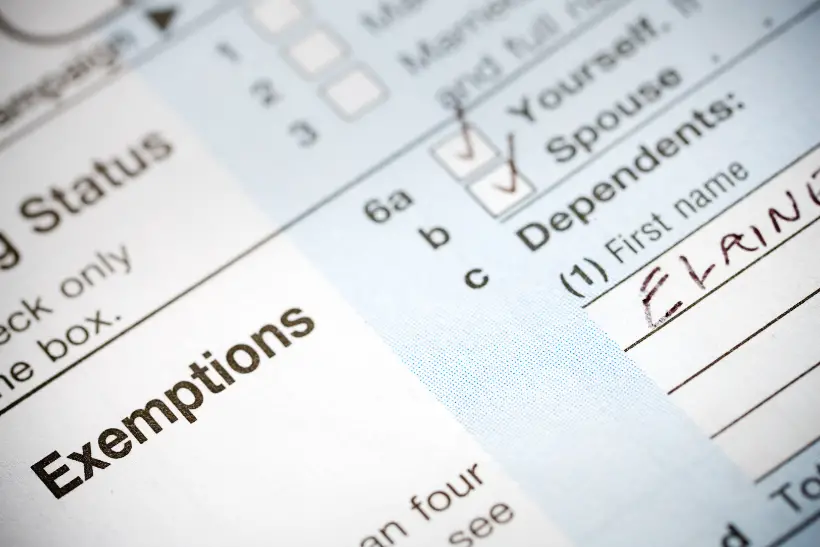
Withhold taxes now or owe taxes next April? [insert superhero tough decision meme]
When filling out your W-4 form, it’s important to carefully consider how many exemptions and allowances to claim. This decision can have a significant impact on your federal income taxes and ultimately determine whether you owe taxes or receive a refund.
Several factors should be taken into account when determining the appropriate number of exemptions and allowances. Firstly, evaluate your tax situation and liability before tax time. If you have multiple sources of income or complex deductions, you may want to claim fewer exemptions to ensure enough taxes are withheld. On the other hand, if you have fewer deductions or a lower tax liability, claiming more allowances may be appropriate.
Life events such as marriage, having children, or becoming a homeowner can also affect your tax situation. For example, claiming additional allowances for dependents on Form W-4 form can potentially reduce your total tax burden.
When it comes to allowances, the primary difference between claiming a single allowance and claiming 0 allowances is the amount of tax withheld from your paycheck.Claiming extra allowances typically results in less tax being withheld, meaning you may receive a larger paycheck throughout the year but potentially owe more in taxes when filing your income tax return.
On the other hand, claiming 0 allowances on Form W-4 ensures maximum tax withholding but may result in a smaller paycheck.
How Many Exemptions Can I Claim if I Am Married and Have Dependents?
When it comes to determining how many exemptions to claim on your tax form, it’s important to understand the difference between an exemption and an allowance. An exemption is a deduction from your taxable income for yourself, your spouse, and each dependent you claim. The term “exemption” is used on the tax form known as the Internal Revenue Service (IRS) Form 1040. On the other hand, an allowance refers to a number you claim on your W-4 form, which helps your employer determine how much federal income tax to withhold from your paycheck.
Several factors should be considered when deciding whether to file jointly or separately. These include each spouse’s income, potential tax credits anddeductions,student loanrepayment plans, and eligibility for certain tax benefits. It is important to evaluate how eachfiling statuswill impact your overalltax liabilitybefore making a decision.
Claiming Exemptions When Married Filing Jointly
When filing jointly, couples have the option to claim exemptions to reduce their overall tax liability. Claiming exemptions can help lower the amount of taxable income, resulting in potential tax savings andallows for a higherstandard deduction, meaning more income is sheltered fromtaxes.
To claim exemptions when filing jointly, couples must meet certain requirements. First, they must be legally married and choose to file their taxes together. Second, they cannot file as married filing separately. Additionally, both spouses must provide valid Social Security numbers for themselves, any dependents they wish to claim, and any individuals they may be claiming as qualifying relatives.
Once these requirements are met, couples can proceed with claiming exemptions by filling out the necessary forms. The first step is to complete Form 1040 or 1040A. On this form, couples will need to provide their personal information, including their names, Social Security numbers, and filing status. They will also need to indicate the number of exemptions they wish to claim.
Furthermore, couples should carefully review the instructions for the specific tax form they are using to ensure they are claiming the correct number of exemptions. The IRS provides detailed guidance on claiming exemptions in their official tax forms and publications.
There are several benefits to claiming exemptions when filing jointly. First and foremost, it can help reduce the taxable income, which in turn lowers the overall tax liability. Additionally, claiming exemptions may make couples eligible for certain tax credits and deductions, further maximizing their tax savings.
In conclusion, claiming exemptions when filing jointly can be advantageous for married couples. However, it is essential to meet the requirements and follow the step-by-step instructions provided by the IRS to ensure accuracy and compliance with tax laws.
Claiming Exemptions When Filing Separately
When filing separately, individuals can claim exemptions by following a specific process. Firstly, they must ensure that all their withheld income tax from the previous year has been refunded before claiming an exemption for the following year. It’s important to note that this can only be done if their financial situation remains unchanged. While this filing status may have some benefits in unique circumstances, such as if one spouse has significant medical expenses, it generally results in a higher tax liability and a lower standard deduction compared to filing jointly.
To claim exemptions when filing separately, individuals must meet certain criteria based on their filing status and income levels. The criteria may vary, but commonly include factors such as being legally married, not filing as married filing jointly, and having a specific level of income.
To proceed with claiming exemptions, individuals should complete the necessary forms, such as Form 1040 or a specific tax form provided by their local tax authority. On these forms, individuals will need to provide personal information such as their name, Social Security number, and filing status. They will also need to indicate the number of exemptions they wish to claim.
It’s important to review the instructions provided by the tax authority to ensure that the correct number of exemptions are being claimed. These instructions will provide detailed guidance on claiming exemptions based on individual circumstances.
Claiming exemptions when filing separately can have certain benefits, such as reducing taxable income and potentially making individuals eligible for specific tax credits and deductions. It is crucial to understand the requirements and criteria for claiming exemptions in order to maximize these benefits.
Adjusting Your Withholding Allowances When You Have Dependents
When you have dependents, it’s important to adjust your withholding allowances to ensure that you are correctly accounting for these additional family members. Adjusting your withholding allowances is the process of determining the right number of exemptions to claim on your tax forms in order to properly calculate your federal income tax withholdings.
If you are married and filing jointly with your spouse, you may be eligible to claim allowances for yourself, your spouse, and each dependent you have. However, if you have multiple jobs or your spouse also works, you may need to account for these additional sources of income and adjust your allowances accordingly.
Accurately determining the right number of allowances is crucial to avoid tax issues and overpaying. If you claim too few allowances, you may have too much tax withheld from your paycheck, resulting in a larger tax refund at the end of the year. On the other hand, if you claim too many allowances, you may not have enough tax withheld and could face a larger tax liability come tax season.
To ensure that you are adjusting your withholding allowances correctly, consult the instructions provided by the tax authority. These instructions will provide guidance on how to determine the appropriate number of allowances based on your filing status, number of jobs, and dependents. Consider using a tax withholding calculator or seeking the advice of a tax professional to ensure that you are accurately adjusting your withholding allowances and maximizing your take-home pay while meeting your tax obligations.
What Are the Benefits of Claiming More Than One Exemption When You Are Married and Have Dependents?
When you are married and have dependents, there are several benefits to claiming more than one exemption on your federal income tax return.
Firstly, claiming more exemptions allows you to reduce the amount of taxes withheld from your paycheck. By adjusting your withholding allowances, you can effectively increase your take-home pay, giving you more money each month to meet your family’s financial needs. This can be particularly beneficial if you are living on a tight budget or have additional expenses due to having dependents.
Additionally, claiming multiple exemptions may make you eligible for various tax credits and deductions. For example, you may qualify for the Child Tax Credit, which can reduce your tax liability by up to $2,000 per child. By properly claiming your exemptions, you can maximize the potential tax savings available to you.
To make the most of your tax situation, it is essential to evaluate your specific financial circumstances. Consider factors such as your combined income, potential deductions, and any other tax credits you may be eligible for. Consulting with a tax professional or using online resources, such as a withholding calculator, can help you determine the optimal number of exemptions to claim.
Single Filers: How Many Exemptions Should I Claim?
Determining how many exemptions to claim on your federal income tax return is an important decision that can affect your paycheck, tax payments and overall life situation. Want a bigger paycheck instead of getting a giant tax refund? Update Form W-4 to drop some of those extra withholding allowances you asked for. But how manytax allowances are too many to drop?
How do you determine the ideal number of exemptions to claim as a single filer?
How many Exemptions to Claim as a Single Taxpayer
If you’re single and getting one paycheck, then claiming one allowance is the smartest move. You could claim two if you’ve got more than one job, or if you’re married but filing separately (but that’s a different story.)
Firstly, consider your filing status and whether you are eligible for any special tax credits or deductions. Single taxpayers have the option to claim a standard deduction or itemize their deductions, depending on which option results in a higher tax benefit.
Secondly, evaluate your income and expenses to determine your tax liability. This includes considering any additional sources of income, such as investments or freelance work, as well as potential deductions or exemptions you might be eligible for.
If you have children, you may also be able to claim them as dependents. This can provide additional tax benefits, such as the child tax credit and the ability to claim certain education-related deductions.
Withholding Allowances for a Single Filer
For single taxpayers, their standard deduction is smaller, their limits for unearned income are lower, and their income tax allowance is overall smaller when tax season arrives.
For a single filer, the number of allowances they can claim will depend on their individual situation. If they have multiple jobs or if they have dependents, they may be eligible to claim additional allowances. This is because having more than one job or having dependents can impact their overall tax liability and may affect the amount of tax that needs to be withheld.
How to Calculate Withholding Allowances as a Single Taxpayer
- Determine your filing status: First, determine your filing status. As a single taxpayer, your filing status will be “Single.” This will be the starting point for calculating your withholding allowances.
- Count the number of jobs you have: If you have only one job, the default number of allowances is usually “1.” However, if you have multiple jobs or if you are married and both you and your spouse work, you may need to adjust the number of allowances.
- Use the IRS Withholding Calculator: To determine the appropriate number of allowances, it is recommended to use the IRS Withholding Calculator. This online tool takes into account your filing status, income, deductions, and credits to provide you with a more accurate result.
- Consider changes in your financial situation: Life events, such as getting married, having a child, or purchasing a home, can impact your tax situation. If any of these events occur during the year, you may need to update your withholding allowances to reflect these changes.
How Many Exemptions Can I Claim if I’m Filing as Head of Household?
If you are filing as Head of Household, it is important to determine how many exemptions you can claim accurately. To qualify as Head of Household, you must meet certain requirements such as being unmarried or considered unmarried on the last day of the year, paying more than half the cost of keeping up a home for yourself and a qualifying person, and having a qualifying person who lived with you for more than half the year.
Heads of household with one dependent child should claim two allowances, generally. However, every individual situation can be different, and it is important to consider your own financial circumstances and consult with a tax professional if needed.

Nick Charveron
Nick Charveron is a licensed tax practitioner and Partner & Co-Founder of Community Tax, LLC. As an Enrolled Agent, the highest tax credential issued by the U.S. Department of Treasury, Nick has unrestricted practice rights before the IRS. He earned his Bachelor of Science from Southern Illinois University while serving with the U.S. Army Illinois National Guard and interning at the U.S. Embassy in Warsaw, Poland. Based in Chicago, Nick combines his passion for finance and real estate with expertise in tax and accounting to help clients navigate complex financial challenges.







